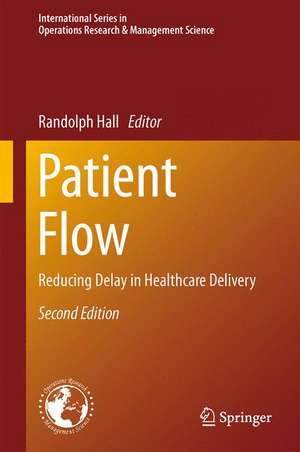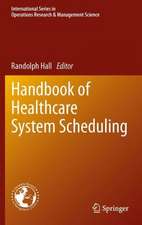Patient Flow: Reducing Delay in Healthcare Delivery: International Series in Operations Research & Management Science, cartea 206
Editat de Randolph Hallen Limba Engleză Hardback – 11 dec 2013
Section 2 addresses crowding and the consequences of delay. Two new chapters (4 and 5) focus on delays in emergency departments, and Chapter 6 then examines medical outcomes that result from waits for surgeries. Section 3 concentrates on management of demand. Chapter 7 presents breakthrough strategies that use real-time monitoring systems for continuous improvement. Chapter 8 looks at the patient appointment system, particularly through the approach of advanced access. Chapter 9 concentrates on managing waiting lists for surgeries, and Chapter 10 examines triage outside of emergency departments, with a focus on allied health programs
Section 4 offers analytical tools and models to support analysis of patient flows. Chapter 11 offers techniques for scheduling staff to match patterns in patient demand. Chapter 12 surveys the literature on simulation modeling, which is widely used for both healthcare design and process improvement. Chapter 13 is new and demonstrates the use of process mapping to represent a complex regional trauma system. Chapter 14 provides methods for forecasting demand for healthcare on a region-wide basis. Chapter 15 presents queueing theory as a method for modeling waits in healthcare, and Chapter 16 focuses on rapid delivery of medication in the event of a catastrophic event.
Section 5 focuses onachieving change. Chapter 17 provides a diagnostic for assessing the state of a hospital and using the state assessment to select improvement strategies. Chapter 18 demonstrates the importance of optimizing care as patients transition from one care setting to the next. Chapter 19 is new and shows how to implement programs that improve patient satisfaction while also improving flow. Chapter 20 illustrates how to evaluate the overall portfolio of patient diagnostic groups to guide system changes, and Chapter 21 provides project management tools to guide the execution of patient flow projects.
| Toate formatele și edițiile | Preț | Express |
|---|---|---|
| Paperback (2) | 957.32 lei 6-8 săpt. | |
| Springer Us – 27 aug 2016 | 957.32 lei 6-8 săpt. | |
| Springer Us – dec 2010 | 1476.24 lei 6-8 săpt. | |
| Hardback (1) | 958.21 lei 6-8 săpt. | |
| Springer Us – 11 dec 2013 | 958.21 lei 6-8 săpt. |
Din seria International Series in Operations Research & Management Science
- 20%
 Preț: 331.25 lei
Preț: 331.25 lei - 9%
 Preț: 696.06 lei
Preț: 696.06 lei - 20%
 Preț: 570.62 lei
Preț: 570.62 lei - 18%
 Preț: 1132.02 lei
Preț: 1132.02 lei - 18%
 Preț: 773.72 lei
Preț: 773.72 lei -
 Preț: 170.40 lei
Preț: 170.40 lei - 17%
 Preț: 459.35 lei
Preț: 459.35 lei - 17%
 Preț: 360.48 lei
Preț: 360.48 lei -
 Preț: 263.40 lei
Preț: 263.40 lei - 24%
 Preț: 905.31 lei
Preț: 905.31 lei - 17%
 Preț: 460.09 lei
Preț: 460.09 lei - 17%
 Preț: 459.35 lei
Preț: 459.35 lei - 20%
 Preț: 631.58 lei
Preț: 631.58 lei - 13%
 Preț: 480.01 lei
Preț: 480.01 lei - 18%
 Preț: 738.28 lei
Preț: 738.28 lei - 18%
 Preț: 1225.94 lei
Preț: 1225.94 lei - 18%
 Preț: 948.92 lei
Preț: 948.92 lei - 18%
 Preț: 703.88 lei
Preț: 703.88 lei - 18%
 Preț: 957.44 lei
Preț: 957.44 lei - 15%
 Preț: 651.84 lei
Preț: 651.84 lei - 20%
 Preț: 336.21 lei
Preț: 336.21 lei - 15%
 Preț: 641.03 lei
Preț: 641.03 lei -
 Preț: 404.29 lei
Preț: 404.29 lei - 18%
 Preț: 950.21 lei
Preț: 950.21 lei - 15%
 Preț: 649.06 lei
Preț: 649.06 lei - 18%
 Preț: 725.75 lei
Preț: 725.75 lei -
 Preț: 394.12 lei
Preț: 394.12 lei - 18%
 Preț: 951.47 lei
Preț: 951.47 lei - 15%
 Preț: 639.59 lei
Preț: 639.59 lei - 18%
 Preț: 773.06 lei
Preț: 773.06 lei - 18%
 Preț: 889.29 lei
Preț: 889.29 lei - 15%
 Preț: 655.60 lei
Preț: 655.60 lei - 15%
 Preț: 640.06 lei
Preț: 640.06 lei
Preț: 958.21 lei
Preț vechi: 1168.55 lei
-18% Nou
Puncte Express: 1437
Preț estimativ în valută:
183.38€ • 190.74$ • 151.39£
183.38€ • 190.74$ • 151.39£
Carte tipărită la comandă
Livrare economică 14-28 aprilie
Preluare comenzi: 021 569.72.76
Specificații
ISBN-13: 9781461495116
ISBN-10: 1461495113
Pagini: 565
Ilustrații: XII, 553 p. 107 illus.
Dimensiuni: 155 x 235 x 35 mm
Greutate: 0.97 kg
Ediția:2nd ed. 2013
Editura: Springer Us
Colecția Springer
Seria International Series in Operations Research & Management Science
Locul publicării:New York, NY, United States
ISBN-10: 1461495113
Pagini: 565
Ilustrații: XII, 553 p. 107 illus.
Dimensiuni: 155 x 235 x 35 mm
Greutate: 0.97 kg
Ediția:2nd ed. 2013
Editura: Springer Us
Colecția Springer
Seria International Series in Operations Research & Management Science
Locul publicării:New York, NY, United States
Public țintă
ResearchCuprins
Modeling Patient Flows Through the Healthcare System.- Interdependency of Hospital Departments and Hospital-Wide Patient Flows.- Hospitals and Clinical Facilities, Processes and Design for Patient Flow.- Emergency Department Crowding, The Nature of the Problem and Why it Matters.- The Consequences of Emergency Department Crowding and Delays for Patients.- Access to Surgery and Medical Consequences of Delays.- Breakthrough Demand-Capacity Management Strategies to Improve Hospital Flow, Safety, and Satisfaction.- Managing Patient Appointments in Primary Care.- Waiting Lists for Surgery.- Triage in Non-Emergency Services.- Personnel Staffing and Scheduling.- Discrete-Event Simulation of Health Care Systems.- Process Mapping of a Regional Trauma System.- Forecasting Demand for Regional Healthcare.- Queueing Analysis in Healthcare.- Rapid Distribution of Medical Supplies.- Using a Diagnostic to Focus Hospital Flow Improvement Strategies.- Improving Patient Satisfaction Through Improved Flow.- Mayo Post Acute Care Program and Care Continuum.- A Logistics Approach for Hospital Process Improvement.- Managing a Patient Flow Improvement Project.
Textul de pe ultima copertă
This book is dedicated to improving healthcare through reducing delays experienced by patients. With an interdisciplinary approach, this new edition, divided into five sections, begins by examining healthcare as an integrated system. Chapter 1 provides a hierarchical model of healthcare, rising from departments, to centers, regions and the “macro system.” A new chapter demonstrates how to use simulation to assess the interaction of system components to achieve performance goals, and Chapter 3 provides hands-on methods for developing process models to identify and remove bottlenecks, and for developing facility plans.
Section 2 addresses crowding and the consequences of delay. Two new chapters (4 and 5) focus on delays in emergency departments, and Chapter 6 then examines medical outcomes that result from waits for surgeries. Section 3 concentrates on management of demand. Chapter 7 presents breakthrough strategies that use real-time monitoring systems for continuous improvement. Chapter 8 looks at the patient appointment system, particularly through the approach of advanced access. Chapter 9 concentrates on managing waiting lists for surgeries, and Chapter 10 examines triage outside of emergency departments, with a focus on allied health programs
Section 4 offers analytical tools and models to support analysis of patient flows. Chapter 11 offers techniques for scheduling staff to match patterns in patient demand. Chapter 12 surveys the literature on simulation modeling, which is widely used for both healthcare design and process improvement. Chapter 13 is new and demonstrates the use of process mapping to represent a complex regional trauma system. Chapter 14 provides methods for forecasting demand for healthcare on a region-wide basis. Chapter 15 presents queueing theory as a method for modeling waits in healthcare, and Chapter 16 focuses on rapid delivery of medication in the event of a catastrophic event.
Section 5 focuses onachieving change. Chapter 17 provides a diagnostic for assessing the state of a hospital and using the state assessment to select improvement strategies. Chapter 18 demonstrates the importance of optimizing care as patients transition from one care setting to the next. Chapter 19 is new and shows how to implement programs that improve patient satisfaction while also improving flow. Chapter 20 illustrates how to evaluate the overall portfolio of patient diagnostic groups to guide system changes, and Chapter 21 provides project management tools to guide the execution of patient flow projects.
Section 2 addresses crowding and the consequences of delay. Two new chapters (4 and 5) focus on delays in emergency departments, and Chapter 6 then examines medical outcomes that result from waits for surgeries. Section 3 concentrates on management of demand. Chapter 7 presents breakthrough strategies that use real-time monitoring systems for continuous improvement. Chapter 8 looks at the patient appointment system, particularly through the approach of advanced access. Chapter 9 concentrates on managing waiting lists for surgeries, and Chapter 10 examines triage outside of emergency departments, with a focus on allied health programs
Section 4 offers analytical tools and models to support analysis of patient flows. Chapter 11 offers techniques for scheduling staff to match patterns in patient demand. Chapter 12 surveys the literature on simulation modeling, which is widely used for both healthcare design and process improvement. Chapter 13 is new and demonstrates the use of process mapping to represent a complex regional trauma system. Chapter 14 provides methods for forecasting demand for healthcare on a region-wide basis. Chapter 15 presents queueing theory as a method for modeling waits in healthcare, and Chapter 16 focuses on rapid delivery of medication in the event of a catastrophic event.
Section 5 focuses onachieving change. Chapter 17 provides a diagnostic for assessing the state of a hospital and using the state assessment to select improvement strategies. Chapter 18 demonstrates the importance of optimizing care as patients transition from one care setting to the next. Chapter 19 is new and shows how to implement programs that improve patient satisfaction while also improving flow. Chapter 20 illustrates how to evaluate the overall portfolio of patient diagnostic groups to guide system changes, and Chapter 21 provides project management tools to guide the execution of patient flow projects.
Caracteristici
Brings field of patient flow operations completely up to date New chapters on Hospital-wide System Patient Flow, Emergency Department Crowding, and six other topics Editor is one of the most prominent and well-published names in the field Includes supplementary material: sn.pub/extras
Recenzii
From the reviews:
"A comprehensive multiauthored manual that outlines the techniques and methods that can be applied to the health care system to improve patient flow, reduce patient delays, and improve overall health care. ... Many examples are illustrated to enhance learning. ... Recommended Readership: Physicians involved with the management of the practice or in leadership roles, office and hospital administrators or managers, and quality improvement champions." (Mark A. Nyman, Mayo Clinic Proceedings, Vol. 82 (3), March, 2007)
"This book, which contains 15 papers on the operational aspects of health-care delivery, was written by doctors, nurses, industrial engineers, and operations research professionals … . Those of us who are deeply interested in the application of management principles and technologies to health-care delivery will be delighted to receive this book. … it will also serve to alert health administrators worldwide that a science has grown up to solve the operational problems in health-care delivery, and that they should be using it in their organizations." (Jamshed A. Modi, Interfaces, Vol. 37 (5), 2007)
"A comprehensive multiauthored manual that outlines the techniques and methods that can be applied to the health care system to improve patient flow, reduce patient delays, and improve overall health care. ... Many examples are illustrated to enhance learning. ... Recommended Readership: Physicians involved with the management of the practice or in leadership roles, office and hospital administrators or managers, and quality improvement champions." (Mark A. Nyman, Mayo Clinic Proceedings, Vol. 82 (3), March, 2007)
"This book, which contains 15 papers on the operational aspects of health-care delivery, was written by doctors, nurses, industrial engineers, and operations research professionals … . Those of us who are deeply interested in the application of management principles and technologies to health-care delivery will be delighted to receive this book. … it will also serve to alert health administrators worldwide that a science has grown up to solve the operational problems in health-care delivery, and that they should be using it in their organizations." (Jamshed A. Modi, Interfaces, Vol. 37 (5), 2007)








